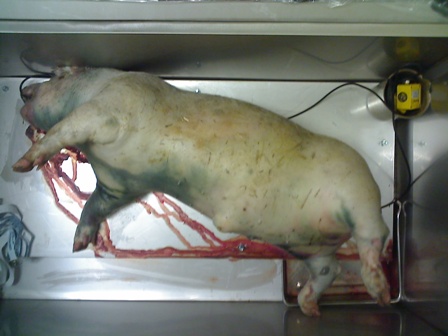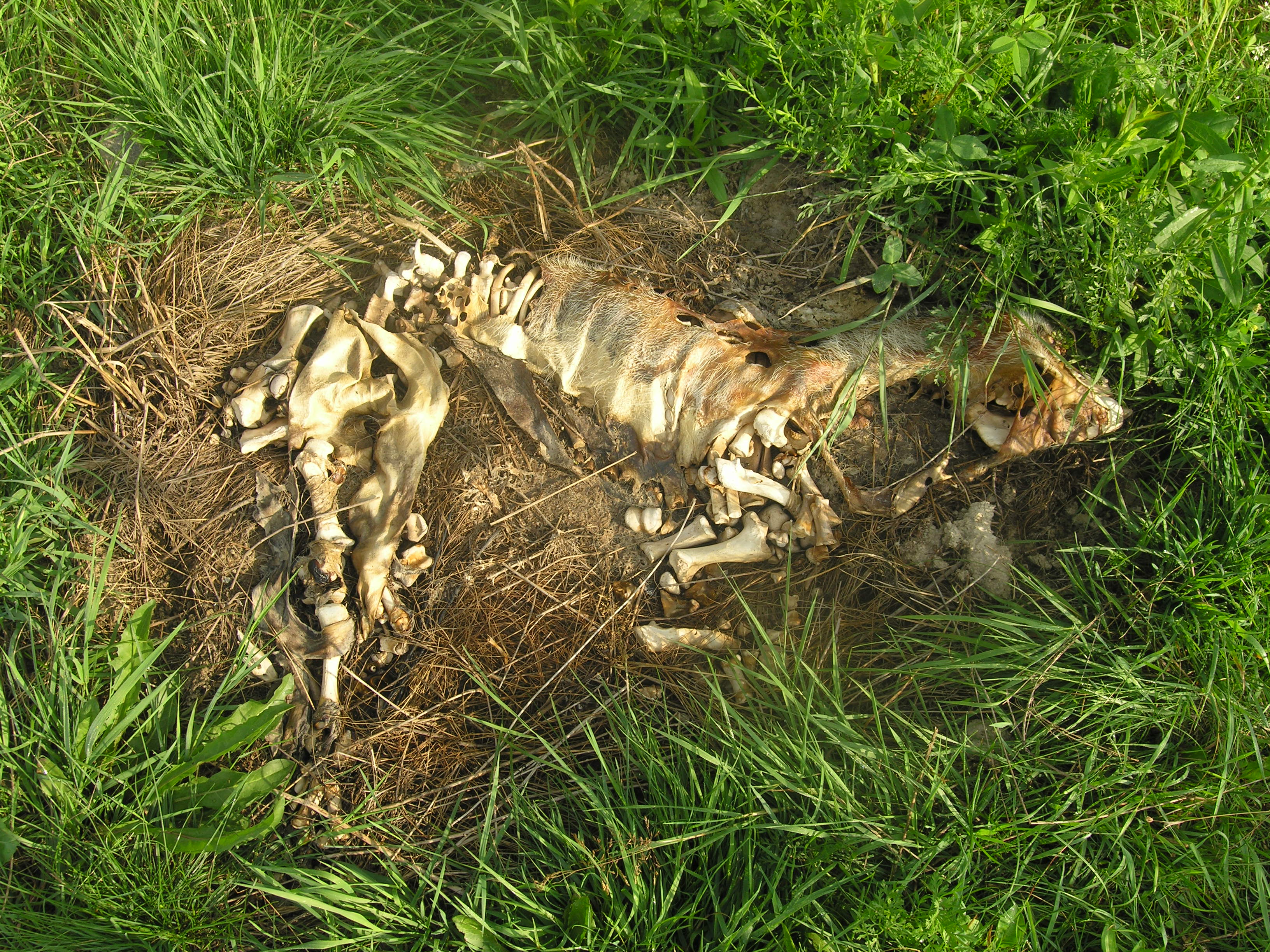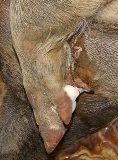Microbiology of decomposition on:
[Wikipedia]
[Google]
[Amazon]
 Microbiology of decomposition is the study of all microorganisms involved in
Microbiology of decomposition is the study of all microorganisms involved in


 It is well known that fungi are heterotrophic for carbon compounds and almost all other nutrients they require. They must obtain these through saprophytic or parasitic associations with their hosts which implicates them in many decomposition processes.
Two major groups of fungi have been identified as being linked to cadaver decomposition:
*
It is well known that fungi are heterotrophic for carbon compounds and almost all other nutrients they require. They must obtain these through saprophytic or parasitic associations with their hosts which implicates them in many decomposition processes.
Two major groups of fungi have been identified as being linked to cadaver decomposition:
*
 Microbiology of decomposition is the study of all microorganisms involved in
Microbiology of decomposition is the study of all microorganisms involved in decomposition
Decomposition or rot is the process by which dead organic substances are broken down into simpler organic or inorganic matter such as carbon dioxide, water, simple sugars and mineral salts. The process is a part of the nutrient cycle and ...
, the chemical and physical processes during which organic matter is broken down and reduced to its original elements.
Decomposition microbiology can be divided between two fields of interest, namely the decomposition of plant
Plants are predominantly photosynthetic eukaryotes of the kingdom Plantae. Historically, the plant kingdom encompassed all living things that were not animals, and included algae and fungi; however, all current definitions of Plantae excl ...
materials and the decomposition of cadavers and carcasses.
The decomposition of plant materials is commonly studied in order to understand the cycling of carbon within a given environment and to understand the subsequent impacts on soil quality. Plant material decomposition is also often referred to as composting. The decomposition of cadavers and carcasses has become an important field of study within forensic taphonomy.
Decomposition microbiology of plant materials
The breakdown of vegetation is highly dependent on oxygen and moisture levels. During decomposition, microorganisms require oxygen for their respiration. If anaerobic conditions dominate the decomposition environment, microbial activity will be slow and thus decomposition will be slow. Appropriate moisture levels are required for microorganisms to proliferate and to actively decompose organic matter. In arid environments, bacteria and fungi dry out and are unable to take part in decomposition. In wet environments, anaerobic conditions will develop and decomposition can also be considerably slowed down. Decomposing microorganisms also require the appropriate plant substrates in order to achieve good levels of decomposition. This usually translates to having appropriate carbon to nitrogen ratios (C:N). The ideal composting carbon-to-nitrogen ratio is thought to be approximately 30:1. As in any microbial process, the decomposition of plant litter by microorganisms will also be dependent on temperature. For example, leaves on the ground will not undergo decomposition during the winter months where snow cover occurs as temperatures are too low to sustain microbial activities.Decomposition microbiology of cadavers and carcasses
The decomposition processes of cadavers and carcasses are studied within the field of forensic taphonomy in order to: *aid in the estimation ofpost-mortem interval
The post-mortem interval (PMI) is the time that has elapsed since an individual's death. When the time of death is not known, the interval may be estimated, and so an approximate time of death established. Postmortem interval estimations can ra ...
(PMI) or time since death;
*aid in the location of potential clandestine graves.
Decomposition microbiology as applied to forensic taphonomy can be divided into 2 groups of studies:
* microorganisms from within the body;
* microorganisms from the decomposition environment.
Microorganisms in the body
When considering cadavers and carcasses,putrefaction
Putrefaction is the fifth stage of death, following pallor mortis, algor mortis, rigor mortis, and livor mortis. This process references the breaking down of a body of an animal, such as a human, post-mortem. In broad terms, it can be view ...
is the proliferation of microorganisms within the body following death and also encompasses the breakdown of tissues brought upon by the growth of bacteria. The first signs of putrefaction are usually the discolorations of the body which can vary between shades of green, blue, red or black depending on 1) where the color changes are observed and 2) how far along within the decomposition process the observation is made. This phenomenon is known as marbling. Discolorations are the results of bile pigments being released following an enzymatic attack of the liver
The liver is a major organ only found in vertebrates which performs many essential biological functions such as detoxification of the organism, and the synthesis of proteins and biochemicals necessary for digestion and growth. In humans, it i ...
, gallbladder and pancreas
The pancreas is an organ of the digestive system and endocrine system of vertebrates. In humans, it is located in the abdomen behind the stomach and functions as a gland. The pancreas is a mixed or heterocrine gland, i.e. it has both an ...
and the release of hemoglobin breakdown products. Proliferation of bacteria throughout the body is accompanied with the production of considerable amounts of gases due to their capacities of fermentation
Fermentation is a metabolic process that produces chemical changes in organic substrates through the action of enzymes. In biochemistry, it is narrowly defined as the extraction of energy from carbohydrates in the absence of oxygen. In food p ...
. As gases accumulate within the bodily cavities the body appears to swell as it enters the bloat stage of decomposition.
As oxygen is present within a body at the beginning of decomposition, aerobic bacteria flourish during the first stages of the process. As the microbial population increases, an accumulation of gases changes the environment into anaerobic conditions which is consequently followed by a change to anaerobic bacteria
An anaerobic organism or anaerobe is any organism that does not require molecular oxygen for growth. It may react negatively or even die if free oxygen is present. In contrast, an aerobic organism (aerobe) is an organism that requires an oxygenat ...
. Gastro-intestinal bacteria are thought to be responsible for the majority of the putrefactive processes that occur in cadavers and carcasses. This can be in part attributed to the impressive concentrations of viable gastro-intestinal organisms and the metabolic capacities they possess allowing them to use an array of different nutrient sources. Gastro-intestinal bacteria are also capable of migrating from the gut to any other region of the body by using the lymphatic system
The lymphatic system, or lymphoid system, is an organ system in vertebrates that is part of the immune system, and complementary to the circulatory system. It consists of a large network of lymphatic vessels, lymph nodes, lymphatic or lymphoid ...
and blood vessel
The blood vessels are the components of the circulatory system that transport blood throughout the human body. These vessels transport blood cells, nutrients, and oxygen to the tissues of the body. They also take waste and carbon dioxide awa ...
s. Furthermore, we know that coliform varieties of ''Staphylococcus
''Staphylococcus'' is a genus of Gram-positive bacteria in the family Staphylococcaceae from the order Bacillales. Under the microscope, they appear spherical ( cocci), and form in grape-like clusters. ''Staphylococcus'' species are faculta ...
'' are important members of the aerobic putrefactive bacteria and that members of the genus ''Clostridium
''Clostridium'' is a genus of anaerobic, Gram-positive bacteria. Species of ''Clostridium'' inhabit soils and the intestinal tract of animals, including humans. This genus includes several significant human pathogens, including the causative a ...
'' make up a large part of anaerobic putrefactive bacteria.

Microorganisms outside the body
Cadavers and carcasses are usually left to decompose in contact with soil whether through burial in a grave or if left to decompose on the soil surface. This allows microorganisms in the soil and air to come in contact with the body and to take part in the decomposition process. Soil microorganism communities also undergo changes as a result of decomposition fluids leaching in the environment. Cadavers and carcasses often show signs of fungal growth suggesting that fungi use the body as a source of nutrients. The exact impacts that decomposition may have on surrounding soil microbial communities remains unclear as some studies have shown increases in microbial biomass following decomposition whereas other have seen decreases. It is likely that the survival of microorganisms throughout the decomposition process is highly dependent of a multitude of environmental factors including pH, temperature and moisture.
Decomposition fluids and soil microbiology
Decomposition fluids entering the soil represent an important influx of organic matter and can also contain a large microbial load of organisms from the body. The area where the majority of the decomposition fluid leaches into the soil is often referred to as a cadaver decomposition island (CDI). It has been observed that decomposition can have a favorable influence on the growth of plants due to increased fertility, a useful tool when trying to locate clandestine graves. The changes in the concentration of nutrients can have lasting effects that are still seen years after a body or carcass has completely disappeared. The influence that the surge in nutrients can have on the microorganisms and vegetation of a given site is not well understood but it appears that decomposition initially has an inhibitory effect for an initial stage before entering a second stage of increased growth.Decomposition fungi
ammonia fungi
Ammonia fungi are fungi that develop fruit bodies exclusively or relatively abundantly on soil that has had ammonia or other nitrogen-containing materials added. The nitrogen materials react as bases by themselves, or after decomposition. The addit ...
* post-putrefactive fungi
Ammonia fungi are broken-down into two groups referred to as "early stage fungi" and "late stage fungi." Such a classification is possible due to the successions that are observed between the types of fungi that fruit in or around a burial environment. The progression between the two groups occurs following the release of nitrogenous products from a body in decomposition. Early stage fungi are described as being ascomycetes
Ascomycota is a phylum of the kingdom Fungi that, together with the Basidiomycota, forms the subkingdom Dikarya. Its members are commonly known as the sac fungi or ascomycetes. It is the largest phylum of Fungi, with over 64,000 species. The defi ...
, deuteromycetes and saprophytic basidiomycetes
Basidiomycota () is one of two large divisions that, together with the Ascomycota, constitute the subkingdom Dikarya (often referred to as the "higher fungi") within the kingdom Fungi. Members are known as basidiomycetes. More specifically, Bas ...
whereas late stage fungi consisted of ectomycorrhizal basidiomycetes.
Decomposition fungi as PMI estimators
Considering the number of forensic cases in which significant amounts of mycelia are observed is quite high, investigating cadaver associated mycota may prove valuable to the scientific community as they have much forensic potential. Only one attempt at using fungi as a PMI marker in a forensic case has been published to date. The study reported the presence of two types of fungi (''Penicillium'' and ''Aspergillus'') on a body found in a well in Japan and stated that they could estimate PMI as being approximately ten days based on the known growth cycles of the fungi in question.See also
*Necrobiome
The necrobiome has been defined as the community of species associated with decaying corpse remains. The process of decomposition is complex. Microbes decompose cadavers, but other organisms including fungi, nematodes, insects, and larger scavenger ...
References
{{Reflist, 30em Environmental microbiology Biostratinomy